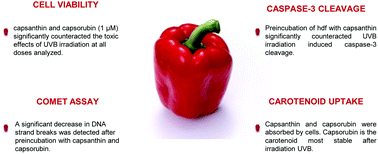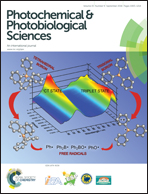Carotenoids exclusively synthesized in red pepper (capsanthin and capsorubin) protect human dermal fibroblasts against UVB induced DNA damage†
Abstract
Photoprotection by dietary carotenoids has been linked to their antioxidant properties, in particular quenching of singlet molecular oxygen and scavenging of peroxyl radicals. Here, we compared the DNA-protection and antioxidant effects of selected carotenoids exclusively synthesized in red pepper (capsanthin and capsorubin) to the xanthophyll lutein. Preincubation of human dermal fibroblasts (hdf) with capsanthin and capsorubin significantly counteracted UVB induced cytotoxicity at doses between 0 and 300 mJ cm−2. Pretreatment of hdf with capsanthin, capsorubin or lutein (1 μM) significantly decreased the formation of DNA strand breaks following irradiation with UVB light. All carotenoids studied decreased caspase-3 cleavage (a marker for UVB-induced apoptosis), however, caspase dependent PARP-1 cleavage was not affected suggesting that the remaining caspase activity is sufficient to promote UVB-induced apoptosis. It is conceivable that carotenoids selectively interfere with cellular responses activated by UVB-mediated damage. Our findings indicate that capsanthin and capsorubin exhibit similar properties to lutein and could be used as a dietary supplement to improve natural photoprotection.


 Please wait while we load your content...
Please wait while we load your content...